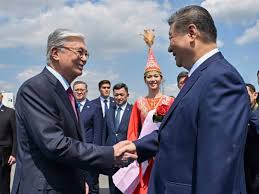
Xi Jinping Meets Central Asian Leaders: Why the Regional Summit Is Significant

 :
| Updated On: 17-Jun-2025 @ 1:56 pm
:
| Updated On: 17-Jun-2025 @ 1:56 pmSHARE
Chinese President Xi Jinping arrived in Kazakhstan on June 17, 2025, to attend the second China–Central Asia Summit, a crucial diplomatic engagement aimed at expanding China’s influence and strategic partnership with Central Asia. The summit, taking place in Astana, the Kazakh capital, includes leaders from Kazakhstan, Kyrgyzstan, Tajikistan, Turkmenistan, and Uzbekistan, and seeks to boost regional cooperation amid global power realignments and rising tensions, particularly in Iran due to its conflict with Israel.
The Astana summit is significant not only for its timing but also symbolically—it marks the first time all five Central Asian nations are co-hosting such a summit with a foreign leader in their region. Xi was received warmly by Kazakh President Kassym-Jomart Tokayev, a fluent Mandarin speaker and former diplomat in China. The summit follows the first China–Central Asia Summit, held in May 2023 in Xi’an, China. Xi is expected to remain in Kazakhstan until June 18, hold bilateral meetings, deliver a keynote speech, and outline strategic plans for the region.
The Chinese Foreign Ministry noted that Xi’s speech would reflect on achievements of the China–Central Asia mechanism, discuss regional and global issues, and highlight cooperation goals. Kazakhstan's Presidential Office confirmed that the two countries would work on deepening their comprehensive strategic partnership.
Central Asia’s Importance to China:
According to Zhao Long of the Shanghai Institutes for International Studies (SIIS), Central Asia is a natural partner for China due to shared pragmatic and strategic interests. While Central Asia offers abundant natural energy resources, China brings to the table markets, technology, and infrastructure expertise. This relationship helps Central Asian states strengthen regional stability, modernize their economies, and expand diplomatic engagement.
Chinese Foreign Ministry spokesperson Lin Jian emphasized that the China–Central Asia mechanism was a mutually agreed initiative, aligned with the region's need for stability and high-quality development. Since the 2023 summit, China has stepped up its engagement, entering what Lin calls a "new era" of relations and "tangible benefits" for the six participating countries. Lin believes this summit will strengthen mutual trust and strategic planning among the nations involved.
C5+1 Framework: China vs the US:
The summit has been likened to a "C5+1" model, referring to the five Central Asian countries plus one global power—here, China. This format was first introduced by the United States in 2015 under President Barack Obama, albeit at the foreign ministers’ level. Since then, India and China have both adopted this model. In 2023, Xi hosted the Central Asian leaders in Xi’an, and months later, Joe Biden became the first US president to meet all five Central Asian leaders under this framework.
However, recent US trade policies under President Donald Trump, especially 10% tariffs on four Central Asian countries and an initially higher 27% on Kazakhstan, have damaged US credibility in the region. In contrast, China uses these policies to present itself as a more reliable partner. Chinese Foreign Minister Wang Yi condemned US trade protectionism, warning it undermines global trade systems and destabilizes economies.
Ultimately, the summit illustrates China’s intent to solidify its influence in Central Asia while countering US and Russian interests.
Contact Us
House. No. : 163, Second Floor Haridev Rd, near Puberun Path, Hatigaon,Guwahati, Assam 781038.
E-mail : assaminkcontact@gmail.com
Contact : +91 8811887662
Enquiry
×
Reporter Login
×